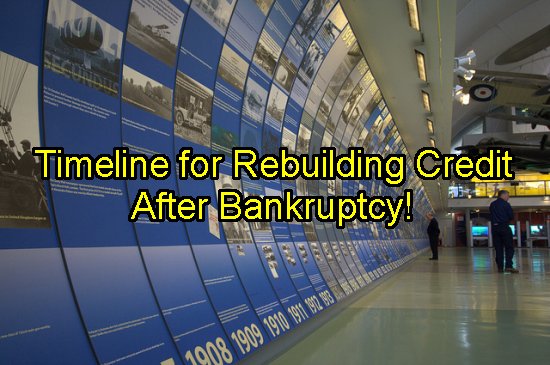
Rebuilding credit after bankruptcy takes time.
Image Source: Flickr User Laura Vain
Bankruptcy will cause your credit score to dip—but wallowing in debt you can’t afford likely has already caused your score to drop. In fact, it might be dropping every month due to maxed out credit cards, late payments, over-limit fees, etc. But once you file, all that stops, and you get a fresh start so you can rebuild your credit. Here’s a look at the timeline to improve your credit after bankruptcy.
#1 Get Your Credit Reports ASAP After Bankruptcy Discharge
Once you get your official bankruptcy discharge, you should get all three of your credit reports—the detailed long-form version—as soon as you can. From there, you need to clean up any errors. All accounts included in the bankruptcy should show a zero balance. In addition, look for any older accounts that should have dropped off and any other mistakes. Get it all cleaned up and ready to go.
#2 Get a Bank Account
If you don’t already have a bank account, you need to get one. If you have a credit union account and any debt from the credit union is part of your bankruptcy, you definitely need to get a new bank account and move your direct deposit so they don’t offset any of your cash for debt. If you get turned down, look for banks that offer second-chance accounts to those struggling to rebuild their finances.
#3 Get a Secured Credit Card
This is the first step, and usually a secured credit card is the first one you’ll be able to obtain after bankruptcy. You’ll still have to wait a few months after your discharge (3-6 months) and make sure that the secured card issuer you’re applying to will accept a post-bankruptcy consumer. Do some homework before you apply to make sure you’ll be approved and then have the cash ready for the secured deposit.
#4 Get a Retail Card
Retail store cards and gas cards are usually easier to get than other unsecured cards but will often come with higher interest rates. Apply for these carefully based on your credit profile, use them regularly, and then pay them off in full each month so that you’ll show the creditor you can use debt responsibly. If you pay off each month, you won’t get killed by the higher interest rate.
#5 Pay Often and On Time
When it comes to your cards, you need to use them in order to get the card issuers to raise your credit limits which, in turn, can improve your credit score. But carrying balances month to month is a slippery slope and can be costly. Pay your card off in full—you can never pay twice a month if you want to make sure you never make a payment late, never max out your card, and never end up in trouble.
#6 Monitor Your Credit Score
Monitoring your credit score lets you know when your score has improved enough to move along the timeline of improving your credit score after bankruptcy. In addition to manually checking your reports, set yourself up an alert so that anytime your credit score changes (for better or worse) or an account is added, you can verify to make sure it’s legitimate and accurate.
#7 Get Unsecured Credit Cards
Once your credit score is healthy, an unsecured card is the next milestone on your timeline of rebuilding your credit. As with secured cards, you should research which card issuers will work with post-bankruptcy filers, their minimum credit score, and other requirements for approval. Only apply for cards you know you’ll get, and don’t do a bunch of inquiries at once.
Rebuilding your credit after North Carolina bankruptcy is a process that takes time. But it’s also a process that won’t take care of itself. You must take deliberate steps to re-establish credit, and Credit Score Keys can help. Call us at 919-495-2365 to find out more or click here.
